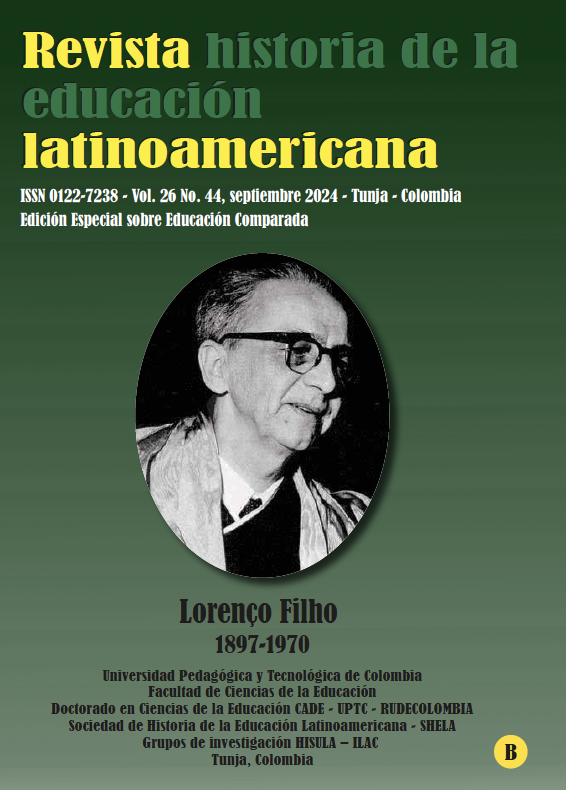Early Childhood Education in Guatemala. A Historical Perspective. 20th and 21st Centuries

Abstract
Objective: to historically establish the contrasts and points of convergence in Guatemalan early childhood education in the 20th and 21st centuries, identifying advances and challenges.
Originality/contribution: the information obtained contributes to the interpretation of events related to early childhood care in Guatemala during the 20th and 21st centuries. Thanks to its exploratory scope, it constitutes a historiographical reference that will favor the study of its evolution and will be used for decision-making in the face of the challenges that arise in the country.
Method: the comparative method was used to make a systematic parallel based on the legal, educational, and temporal frameworks of early childhood care in Guatemala during the 20th and 21st centuries, in order to understand, interpret, and analyze past and current events and challenges.
Strategies/Information Collection: the basic elements for recovering information were analysis, document review, and interviews.
Conclusions: during the 20th century, early childhood education was limited to urban areas, which meant that indigenous and rural Guatemalan children were excluded and, since 1977, only partially served for Hispanicization purposes and with unequal access. This situation began to change with the ratification of the Rights of the Child in 1990 and the approval of laws and policies that protect and promote early childhood care in an equitable and appropriate manner. Early childhood education, based on the analysis and interpretation carried out, shows progress in the 21st century, but also great challenges that require the materialization of timely, pertinent and inclusive care for children between 0 and 6 years old.
Keywords
Early childhood, early childhood education, pre-kindergarten, exclusion-challenges, Guatemala.
Author Biography
Ana María Hernández Ayala
Doctoranda del Doctorado en Historia y Estudios Humanísticos: Europa, América, Arte y Lenguas. Maestría en Liderazgo y Gestión Educativa. Investigadora del Instituto de Investigaciones Educativas EFPEM-USAC. Profesora en la Escuela de Profesores de Enseñanza Media EFPEM-USAC. Directora de la Dirección General de Gestión de Calidad Educativa (DIGECADE) del Ministerio de Educación de Guatemala 2016-2020. anama2777@gmail.com
References
- Arreaga de León de Padilla, Aura Gabina. “La educación parvularia en Guatemala y su relación en los niveles de desarrollo integral del niño que ingresa a la escuela primaria. Guatemala”. Tesis, Universidad de San Carlos de Guatemala, Facultad de Humanidades, 1994.
- Cortés Cortés, Manuel y Miriam Iglesias. Generalidades sobre la metodología de la investigación. Ciudad del Carmen: México: Universidad Autónoma del Carmen, 2004.
- Decreto n.° 12-91, Ley de Educación Nacional, 1991. Guatemala. https://www.acnur.org/fileadmin/Documentos/BDL/2008/6728.pdf
- Foronda Prado de Vargas, María Isabel. La educación de párvulos en Guatemala. Monografía. Guatemala: Ministerio de Educación, Editorial José Pineda Ibarra, 1967.
- González Contró, Mónica. Derechos de los niños y las niñas. México D.F.: Instituto Nacional de Estudios Históricos de las Revoluciones de México, Universidad Nacional Autónoma de México, Instituto de Investigaciones Jurídicas, 2015. https://www.inehrm.gob.mx/work/models/Constitucion1917/Resource/1292/ninas_y_ninos_pdf_electronico.pdf
- González Orellana, Carlos. Historia de la educación en Guatemala, 5.a ed. Guatemala: Editorial Universitaria, Universidad de San Carlos de Guatemala, 1997.
- Historia de la educación (blog). “La reforma liberal y la organización de la educación pública”. 2014. https://pedagogiag2014.blogspot.com/2014/10/la-reforma-liberal-y-laorganizacion-de.html
- Méndez Cabrita, Carmen, Ángel Marín Pérez, Alex Cruz Enríquez y Carlos Rosero Martínez. “El paradigma hermenéutico. Una propuesta para el reconocimiento del ‘otro’ en las comunidades indígenas del Ecuador”. Revista Dilemas Contemporáneos: Educación, Política y Valores 6, n.° 52 (2019). https://dilemascontemporaneoseducacionpoliticayvalores.com/index.php/dilemas/article/view/1456/1699
- Menéndez, Luis Antonio. La educación en Guatemala, 1954-2000: enfoque histórico estadístico. Guatemala: Universidad de Texas, Editorial C.J.C. Computación, 2002.
- Mesa Temática de la Primera Infancia, Gobierno de Guatemala. Política Pública de Desarrollo Integral de la Primera Infancia de Guatemala. 2024. https://www.unicef.org/guatemala/media/7186/file/Pol%C3%ADtica%20P%C3%BAblica%20de%20Desarrollo%20Integral%20de%20la%20Primera%20Infancia%20de%20GuatemalaI%202024-2044%20LOW.pdf.pdf
- Naciones Unidas. Comité de los Derechos del Niño. 1996. https://www.ohchr.org/es/treaty-bodies/crc
- Pagés, Joan. “La comparación en la enseñanza de la historia”. La Historia Enseñada n.° 9 (2005-2006): 17-35. http://www.ub.edu/histodidactica/images/documentos/pdf/comparacion_ensenanza_historia.pdf
- Sazo García, Magali. “Educación infantil en Guatemala para la primera infancia (1980-2020)”. Guatemala, (2024).
- Secretaría de Planificación y Programación de la Presidencia de Guatemala. Política Pública Desarrollo Integral de la Primera Infancia Guatemala Invierte en el desarrollo integral de la Primera Infancia 2010-2020. Versión final. Guatemala: Gobierno de la República de Guatemala, 2010. https://ecursos.segeplan.gob.gt/CAPP/documentos/20/Pol%C3%ADtica%20P%C3%BAblica%20Primera%20Infancia.pdf
- UNICEF. Los niños, niñas y adolescentes tienen derechos. S. f. https://www.unicef.org/guatemala/ninos-ninas-adolescentes-tienen-derechos
